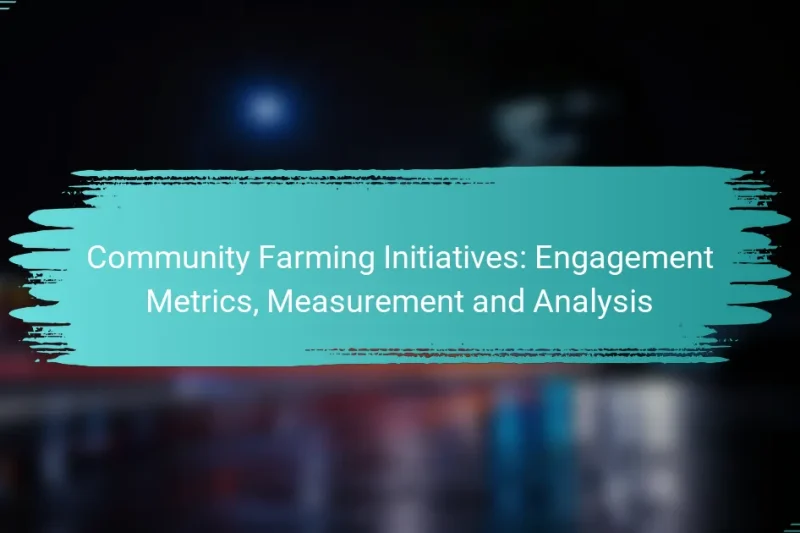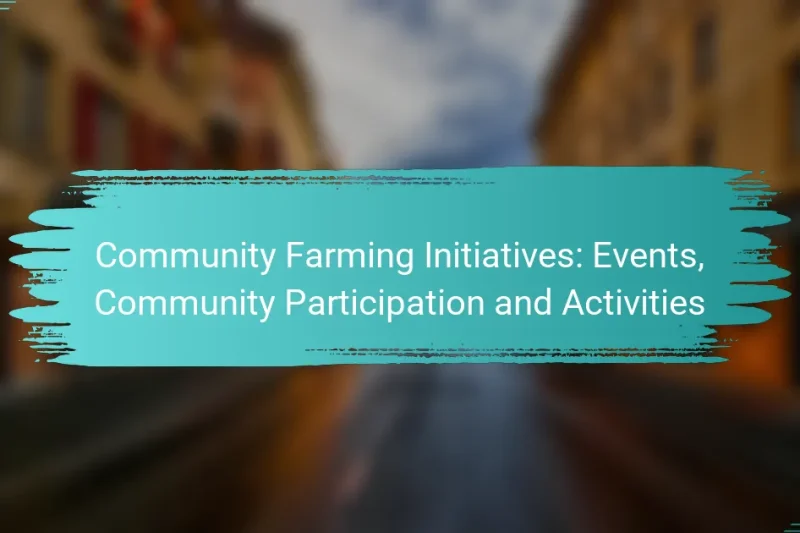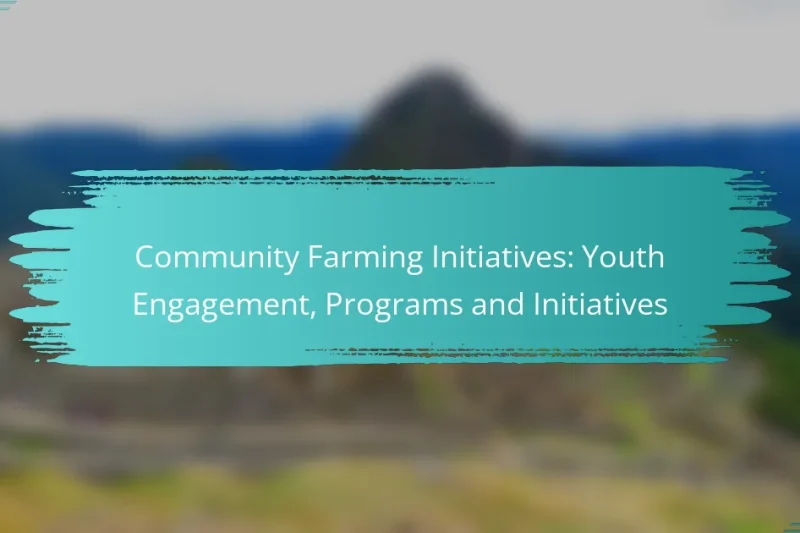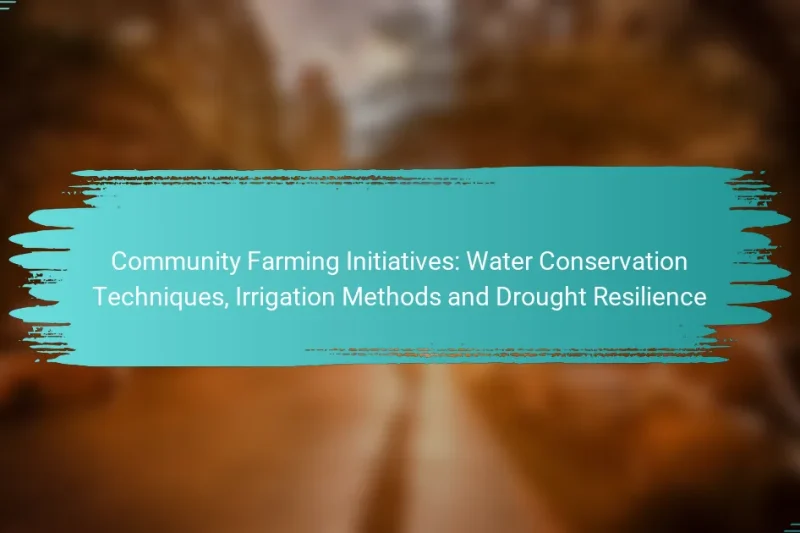Community farming initiatives play a vital role in enhancing biodiversity by fostering diverse ecosystems that support … Community Farming Initiatives: Biodiversity Creation, Habitat Enhancement and Crop VarietyRead more
Community farming initiatives play a vital role in urban areas by enhancing access to fresh produce, fostering social connections, and improving environmental conditions. These collaborative spaces allow residents to engage in sustainable practices, promote healthy eating, and strengthen community ties, ultimately enriching the quality of life in cities.
Community Farming Initiatives: Urban Challenges, Funding Issues and Land Conflicts
Community farming initiatives in urban areas play a crucial role in enhancing food security and promoting … Community Farming Initiatives: Urban Challenges, Funding Issues and Land ConflictsRead more
Community Farming Initiatives: Engagement Metrics, Measurement and Analysis
Community farming initiatives play a crucial role in enhancing local engagement by promoting active participation and … Community Farming Initiatives: Engagement Metrics, Measurement and AnalysisRead more
Community Farming Initiatives: Events, Community Participation and Activities
Community farming initiatives play a vital role in enhancing local food security by providing access to … Community Farming Initiatives: Events, Community Participation and ActivitiesRead more
Community Farming Initiatives: Land Use Conflicts, Zoning Regulations and Community Engagement
Community farming initiatives represent a vital collaboration among local residents to cultivate land for agricultural purposes, … Community Farming Initiatives: Land Use Conflicts, Zoning Regulations and Community EngagementRead more
Community Farming Models: CSA, Urban Gardens and Cooperative Models
Community farming models, such as Community Supported Agriculture (CSA), urban gardens, and cooperative farming, play a … Community Farming Models: CSA, Urban Gardens and Cooperative ModelsRead more
Community Farming Initiatives: Organic Practices, Soil Health and Crop Diversity
Community farming initiatives play a vital role in enhancing soil health and promoting sustainable agricultural practices. … Community Farming Initiatives: Organic Practices, Soil Health and Crop DiversityRead more
Community Farming Initiatives: Youth Engagement, Programs and Initiatives
Community farming initiatives offer youth a unique opportunity to engage in hands-on agricultural activities that promote … Community Farming Initiatives: Youth Engagement, Programs and InitiativesRead more
Community Farming Initiatives: Water Conservation Techniques, Irrigation Methods and Drought Resilience
Community farming initiatives play a crucial role in promoting water conservation techniques and enhancing drought resilience. … Community Farming Initiatives: Water Conservation Techniques, Irrigation Methods and Drought ResilienceRead more
Community Farming Initiatives: Permaculture Principles, Design Strategies and Ecosystem Benefits
Community farming initiatives play a vital role in urban environments by providing fresh food, fostering social … Community Farming Initiatives: Permaculture Principles, Design Strategies and Ecosystem BenefitsRead more
How do community farming initiatives benefit urban areas?
Community farming initiatives provide urban areas with numerous advantages, including increased access to fresh produce, strengthened social ties, and improved environmental conditions. These initiatives create spaces where residents can collaborate, learn, and grow food, ultimately enhancing the quality of life in cities.
Improved food security
Community farming initiatives directly contribute to improved food security by increasing the availability of fresh fruits and vegetables in urban settings. By growing food locally, these initiatives reduce reliance on distant supply chains, which can be disrupted by various factors such as climate change or economic fluctuations.
Urban farms often focus on cultivating diverse crops, which can help meet the dietary needs of the community. For example, a community garden might produce a variety of vegetables that cater to different cultural preferences, ensuring that all residents have access to nutritious food options.
Enhanced community engagement
Community farming initiatives foster enhanced community engagement by bringing people together around a common goal: growing food. These projects encourage collaboration among residents, promoting social interactions and building relationships that strengthen community bonds.
Participation in local farming activities can also empower individuals by providing them with skills and knowledge related to agriculture and sustainability. Workshops or volunteer days can engage residents of all ages, creating a sense of ownership and pride in the community’s food sources.
Environmental sustainability
Community farming initiatives promote environmental sustainability by utilizing practices that reduce carbon footprints and enhance biodiversity. Urban farms often implement organic farming methods, which minimize chemical use and promote healthier ecosystems.
Additionally, these initiatives can improve urban landscapes by transforming vacant lots or underutilized spaces into green areas. This not only provides habitats for local wildlife but also helps mitigate urban heat effects and manage stormwater, contributing to a healthier urban environment overall.
What are successful examples of community farming initiatives in the US?
Successful community farming initiatives in the US focus on local engagement, sustainable practices, and food accessibility. These programs often foster community ties while promoting environmental stewardship and healthy eating.
Brooklyn Grange in New York
Brooklyn Grange operates rooftop farms across New York City, transforming underutilized spaces into productive agricultural sites. This initiative not only provides fresh produce but also offers educational programs and workshops on urban farming techniques.
By utilizing organic practices, Brooklyn Grange emphasizes sustainability and community involvement. They engage local residents through volunteer opportunities and events, fostering a sense of ownership and connection to the food they grow.
Community Farm Alliance in Kentucky
The Community Farm Alliance (CFA) focuses on building a sustainable food system in Kentucky by supporting local farmers and promoting community gardens. CFA advocates for policies that benefit small-scale agriculture and provides resources for farmers to thrive.
Through initiatives like the Kentucky Farmers Market Association, CFA helps connect local producers with consumers, enhancing access to fresh, locally grown food. Their efforts also include training programs that empower communities to start their own farming projects, ensuring long-term food security.
How can individuals get involved in community farming?
Individuals can engage in community farming by joining local groups and participating in organized volunteer activities. These initiatives not only enhance local food production but also foster community bonds and environmental stewardship.
Joining local farming groups
Joining local farming groups is a practical way to get involved in community farming. These groups often focus on sustainable practices, education, and collaboration among members. Look for organizations in your area that align with your interests, whether they focus on organic farming, permaculture, or urban agriculture.
Many groups hold regular meetings, workshops, and social events, providing opportunities to learn and network. Check local community boards, social media platforms, or agricultural extension offices for listings of active groups.
Participating in volunteer days
Participating in volunteer days is another effective way to contribute to community farming efforts. Many farms and community gardens organize specific days for volunteers to help with planting, harvesting, and maintenance tasks. This hands-on involvement not only supports the farm but also allows you to gain practical skills.
To find volunteer opportunities, visit local farming websites or community centers. It’s advisable to sign up in advance, as spots can fill quickly. Bring appropriate clothing and tools if required, and be prepared for a rewarding experience that connects you with fellow community members.
What are the challenges faced by community farming initiatives?
Community farming initiatives encounter several challenges that can hinder their effectiveness and sustainability. Key issues include funding and resource limitations, as well as zoning and land use regulations that can restrict operations.
Funding and resource limitations
Funding is often a significant barrier for community farming initiatives. Many rely on grants, donations, or crowdfunding, which can be unpredictable and insufficient for long-term sustainability. Establishing partnerships with local businesses or seeking sponsorships can help alleviate some financial pressures.
Additionally, resource limitations such as access to tools, seeds, and educational materials can impact the success of these initiatives. Collaborating with local agricultural organizations or universities can provide valuable resources and expertise, enhancing the overall effectiveness of community farms.
Zoning and land use regulations
Zoning laws and land use regulations can pose challenges for community farming initiatives, as they often dictate what types of activities can occur on specific parcels of land. Understanding local regulations is crucial for compliance and can prevent potential legal issues. Engaging with local government officials can help clarify these regulations and identify opportunities for community farming.
In some areas, community farms may need to apply for special permits or variances to operate legally. It's essential to research these requirements early in the planning process to avoid delays and ensure that the initiative can thrive within the existing legal framework.
What criteria should be considered when starting a community farm?
When starting a community farm, it's essential to consider factors such as location, community needs, available resources, and regulatory requirements. These criteria help ensure the farm meets local demands and operates effectively.
Location and accessibility
The location of a community farm is critical for its success. It should be easily accessible to community members, ideally within walking or biking distance, to encourage participation. Consider proximity to public transportation and parking availability for those who may drive.
Additionally, the site should have suitable soil quality, sunlight exposure, and water access. Urban areas may require innovative solutions like rooftop gardens or vertical farming to maximize space and resources.
Community needs assessment
Conducting a community needs assessment is vital to understand the specific desires and requirements of local residents. Engage with community members through surveys, focus groups, or public meetings to gather insights on what types of produce or activities they value most.
This assessment should also identify potential barriers to participation, such as lack of knowledge or resources. Addressing these challenges early on can help foster a more inclusive and supportive environment for the community farm.
How do community farming initiatives impact local economies?
Community farming initiatives significantly boost local economies by creating jobs and supporting local businesses. These initiatives foster economic resilience by promoting sustainable practices and enhancing food security within communities.
Job creation
Community farming initiatives generate employment opportunities in various sectors, including agriculture, distribution, and retail. Jobs can range from farm laborers to managerial positions, often providing training and skill development for local residents.
For instance, a community farm may employ dozens of individuals, contributing to a reduction in local unemployment rates. Additionally, these jobs often pay competitive wages, which can help improve the overall economic situation of the community.
Support for local businesses
Community farms often source materials and services from nearby businesses, creating a ripple effect that strengthens the local economy. This support can include purchasing seeds, equipment, and other supplies from local vendors, which helps keep money circulating within the community.
Moreover, community farms can partner with local restaurants and markets to sell fresh produce, enhancing the visibility and profitability of these businesses. Such collaborations not only increase sales but also promote a farm-to-table culture that benefits consumers and producers alike.
What are the environmental benefits of community farming?
Community farming provides significant environmental benefits by promoting sustainable agricultural practices and enhancing local ecosystems. These initiatives often focus on organic methods, which reduce chemical use and improve soil health, leading to a more resilient environment.
Biodiversity promotion
Community farming plays a crucial role in promoting biodiversity by creating habitats for various plant and animal species. By cultivating a diverse range of crops and using organic farming techniques, these initiatives help maintain ecological balance and support pollinators, which are vital for food production.
Implementing crop rotation and intercropping strategies can further enhance biodiversity. For example, planting legumes alongside vegetables can improve soil nitrogen levels while providing shelter for beneficial insects. This diversity not only supports wildlife but also reduces the risk of pests and diseases, leading to healthier crops.
To maximize biodiversity benefits, community farms should consider local native species when selecting plants. Engaging the community in educational workshops about the importance of biodiversity can foster greater awareness and participation in conservation efforts.














